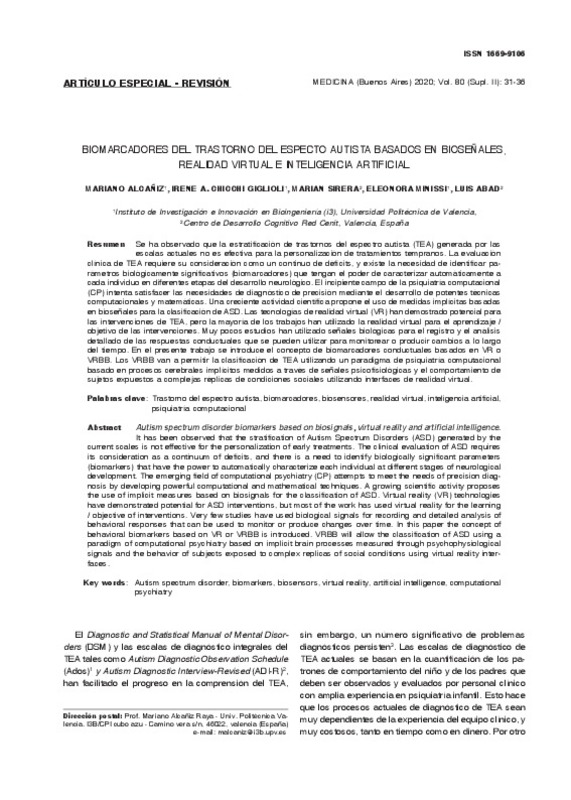JavaScript is disabled for your browser. Some features of this site may not work without it.
Buscar en RiuNet
Listar
Mi cuenta
Estadísticas
Ayuda RiuNet
Admin. UPV
Biomarcadores del trastorno del espectro autista basados en bioseñales, realidad virtual e inteligencia artificial
Mostrar el registro sencillo del ítem
Ficheros en el ítem
| dc.contributor.author | Alcañiz Raya, Mariano Luis
|
es_ES |
| dc.contributor.author | CHICCHI-GIGLIOLI, IRENE ALICE
|
es_ES |
| dc.contributor.author | Sirera, Marian
|
es_ES |
| dc.contributor.author | Minissi, Maria Eleonora
|
es_ES |
| dc.contributor.author | Abad, Luis
|
es_ES |
| dc.date.accessioned | 2021-09-09T03:35:55Z | |
| dc.date.available | 2021-09-09T03:35:55Z | |
| dc.date.issued | 2020 | es_ES |
| dc.identifier.uri | http://hdl.handle.net/10251/171695 | |
| dc.description.abstract | [ES] Se ha observado que la estratificación de trastornos del espectro autista (TEA) generada por las escalas actuales no es efectiva para la personalización de tratamientos tempranos. La evaluación clínica de TEA requiere su consideración como un continuo de déficits, y existe la necesidad de identificar parámetros biológicamente significativos (biomarcadores) que tengan el poder de caracterizar automáticamente a cada individuo en diferentes etapas del desarrollo neurológico. El incipiente campo de la psiquiatría computacional (CP) intenta satisfacer las necesidades de diagnóstico de precisión mediante el desarrollo de potentes técnicas computacionales y matemáticas. Una creciente actividad científica propone el uso de medidas implícitas basadas en bioseñales para la clasificación de ASD. Las tecnologías de realidad virtual (VR) han demostrado potencial para las intervenciones de TEA, pero la mayoría de los trabajos han utilizado la realidad virtual para el aprendizaje / objetivo de las intervenciones. Muy pocos estudios han utilizado señales biológicas para el registro y el análisis detallado de las respuestas conductuales que se pueden utilizar para monitorear o producir cambios a lo largo del tiempo. En el presente trabajo se introduce el concepto de biomarcadores conductuales basados en VR o VRBB. Los VRBB van a permitir la clasificación de TEA utilizando un paradigma de psiquiatría computacional basado en procesos cerebrales implícitos medidos a través de señales psicofisiológicas y el comportamiento de sujetos expuestos a complejas réplicas de condiciones sociales utilizando interfaces de realidad virtual. | es_ES |
| dc.description.abstract | [EN] It has been observed that the stratification of Autism Spectrum Disorders (ASD) generated by the current scales is not effective for the personalization of early treatments. The clinical evaluation of ASD requires its consideration as a continuum of deficits, and there is a need to identify biologically significant parameters (biomarkers) that have the power to automatically characterize each individual at different stages of neurological development. The emerging field of computational psychiatry (CP) attempts to meet the needs of precision diagnosis by developing powerful computational and mathematical techniques. A growing scientific activity proposes the use of implicit measures based on biosignals for the classification of ASD. Virtual reality (VR) technologies have demonstrated potential for ASD interventions, but most of the work has used virtual reality for the learning / objective of interventions. Very few studies have used biological signals for recording and detailed analysis of behavioral responses that can be used to monitor or produce changes over time. In this paper the concept of behavioral biomarkers based on VR or VRBB is introduced. VRBB will allow the classification of ASD using a paradigm of computational psychiatry based on implicit brain processes measured through psychophysiological signals and the behavior of subjects exposed to complex replicas of social conditions using virtual reality interfaces. | es_ES |
| dc.language | Español | es_ES |
| dc.publisher | Fundación Revista Medicina | es_ES |
| dc.relation.ispartof | Medicina (Buenos Aires) (Online) | es_ES |
| dc.rights | Reconocimiento (by) | es_ES |
| dc.subject | Trastornos del espectro autista | es_ES |
| dc.subject | Biomarcadores | es_ES |
| dc.subject | Biosensores | es_ES |
| dc.subject | Realidad virtual | es_ES |
| dc.subject | Inteligencia artificial | es_ES |
| dc.subject | Psiquiatría computacional | es_ES |
| dc.subject | Autism spectrum disorder | es_ES |
| dc.subject | Biomarkers | es_ES |
| dc.subject | Biosensors | es_ES |
| dc.subject | Virtual reality | es_ES |
| dc.subject | Artificial intelligence | es_ES |
| dc.subject | Computational psychiatry | es_ES |
| dc.subject.classification | EXPRESION GRAFICA EN LA INGENIERIA | es_ES |
| dc.title | Biomarcadores del trastorno del espectro autista basados en bioseñales, realidad virtual e inteligencia artificial | es_ES |
| dc.type | Artículo | es_ES |
| dc.rights.accessRights | Abierto | es_ES |
| dc.contributor.affiliation | Universitat Politècnica de València. Instituto Interuniversitario de Investigación en Bioingeniería y Tecnología Orientada al Ser Humano - Institut Interuniversitari d'Investigació en Bioenginyeria i Tecnologia Orientada a l'Ésser Humà | es_ES |
| dc.contributor.affiliation | Universitat Politècnica de València. Departamento de Ingeniería Gráfica - Departament d'Enginyeria Gràfica | es_ES |
| dc.description.bibliographicCitation | Alcañiz Raya, ML.; Chicchi-Giglioli, IA.; Sirera, M.; Minissi, ME.; Abad, L. (2020). Biomarcadores del trastorno del espectro autista basados en bioseñales, realidad virtual e inteligencia artificial. Medicina (Buenos Aires) (Online). 80(supl II):10-17. http://hdl.handle.net/10251/171695 | es_ES |
| dc.description.accrualMethod | S | es_ES |
| dc.relation.publisherversion | https://www.medicinabuenosaires.com/ | es_ES |
| dc.description.upvformatpinicio | 10 | es_ES |
| dc.description.upvformatpfin | 17 | es_ES |
| dc.type.version | info:eu-repo/semantics/publishedVersion | es_ES |
| dc.description.volume | 80 | es_ES |
| dc.description.issue | supl II | es_ES |
| dc.identifier.eissn | 1669-9106 | es_ES |
| dc.relation.pasarela | S\405087 | es_ES |
| dc.contributor.funder | CEDECO RED CENIT S.L. | es_ES |






